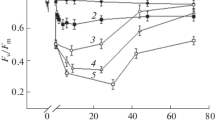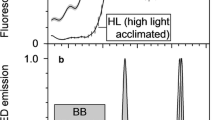Abstract
We have used the technique of thermoluminescence (TL) to investigate high-light-induced chlorophyll fluorescence quenching phenomena in barley leaves, and have shown it to be a powerful tool in such investigations. TL measurements were taken from wild-type and chlorina f2 barley leaves which had been dark-adapted or exposed to 20 min illumination of varying irradiance or given varying periods of recovery following strong irradiance. We have found strong evidence that there is a sustained trans-thylakoid ΔpH in leaves following illumination, and that this ΔpH gives rise to quenching of chlorophyll fluorescence which has previously been identified as a slowly-relaxing component of antenna-related protective energy dissipation; we have identified a state of the PS II reaction centre resulting from high light treatments which is apparently able to perform normal charge separation and electron transport but which is ‘non-photochemically’ quenched, in that the application of a light pulse of high irradiance cannot cause the formation of a high fluorescent state; and we have provided evidence that a transient state of the PS II reaction centre is formed during recovery from such high light treatments, in which electron transport from QAto QBis apparently impaired.
Similar content being viewed by others
References
Anderson JM and Aro E-M (1994) Grana stacking and protection of Photosystem II in thylakoid membranes of higher plant leaves under sustained high irradiance: An hypothesis. Photosynth Res 41: 315-326
Aro E-M, Kettunen R and Tyystjärvi E (1992) ATP and light regulate D1 protein modification and degradation. Role of D1* in photoinhibition. FEBS Lett 297: 29-33
Aro EM, Virgin I and Andersson B (1993) Photoinhibition of Photosystem II — inactivation, protein damage and turnover. Biochim Biophys Acta 1143: 113-134
Barber J (1995) Molecular basis of the vulnerability of Photosystem II damage by light. Aust J Plant Physiol 22: 75-85
Bradbury M and Baker NR (1986) The kinetics of photoinhibition of the photosynthetic apparatus in pea chloroplasts. Plant Cell Environ 9: 289-297
Briantais J-M (1994) Light-harvesting chlorophyll a/bcomplex requirement for regulation of Photosystem II photochemistry by non-photochemical quenching. Photosynth Res 40: 287-294
Briantais J-M, Ducruet J-M, Hodges M and Krause GH (1992) The effects of low temperature acclimation and photoinhibitory treatments on Photosystem 2 studied by thermoluminescence and fluorescence decay kinetics. Photosynth Res 31: 1-10
Brudvig GW, Casey JL and Sauer K (1983) The effect of temperature on the formation and decay of the multiline electron-paramagnetic-resonance signal species associated with photosynthetic oxygen evolution. Biochim Biophys Acta 723: 366-371
Buser CA, Diner BA and Brudvig GW (1992) Photooxidation of cytochrome b559in oxygen-evolving Photosystem II. Biochemistry 31: 11449-11459
Demmig-Adams B and Adams WW (1992) Photoprotection and other responses of plants to high light stress. Annu Rev Plant Physiol Plant Mol Biol 43: 599-626
Ducruet J-M and Miranda T (1992) Graphical and numerical analysis of thermoluminescence and fluorescence Foemission in photosynthetic material. Photosynth Res 33: 15-27
Falk S, Krol M, Maxwell DP, Rezanhoff DA, Gray GR and Huner NPA (1994) Changes in in vivofluorescence quenching in rye and barley as a function of reduced PS II light-harvesting antenna size. Physiol Plant 91: 551-558
Gilmore AM and Bjørkman O (1994) Adenine nucleotides and the xanthophyll cycle in leaves. 2. Comparison of the effects of CO2-and temperature-limited photosynthesis on photosystem-II fluorescence quenching, the adenylate energy charge and violaxanthin de-epoxidation in cotton. Planta 192: 537-544
Horton P and Hague A (1988) Studies on the induction of chlorophyll fluorescence in isolated barley protoplasts. 4. Resolution of non-photochemical quenching. Biochim Biophys Acta 932: 107-115
Horton P, Ruban AV, Rees D, Pascal AA, Noctor GD and Young AJ (1991) Control of the light-harvesting function of chloroplast membranes by aggregation of the LHC II chlorophyll-protein complex. FEBS Lett 292: 1-4
Horton P, Ruban AV and Walters RG (1996) Regulation of light harvesting in green plants. Annu Rev Plant Physiol Plant Mol Biol 47: 655-684
Inoue Y (1996) Photosynthetic thermoluminescence as a simple probe of Photosystem II electron transport. In: Amesz J and Hoff AJ (eds) Biophysical Techniques in Photosynthesis, pp 93-107. Kluwer Academic Publishers, Dordrecht, the Netherlands
Inoue Y, Yamashita T, Kobayashi Y and Shibata K (1977) Thermoluminescence changes during inactivation and reactivation of the oxygen-evolving system in isolated chloroplasts. FEBS Lett 82: 303-306
Johnson GN and Krieger A (1994) Thermoluminescence as a probe of Photosystem II in intact leaves: Non-photochemical fluorescence quenching in peas grown in an intermittent light regime. Photosynth Res 41: 371-379
Johnson GN, Boussac A and Rutherford AW (1994) The origin of the 40–50°C thermoluminescence band in Photosystem II. Biochim Biophys Acta 1184: 85-92
Keren N, Gong HS and Ohad I (1995) Oscillations of reaction centre II D1 protein degradation in vivoinduced by repetitive flashes: Correlation between the level of RCIIQ −B and protein degradation in low light. J Biol Chem 270: 806-814
Koike H, Siderer Y, Ono T and Inoue Y (1986) Assignment of thermoluminescence A band to S3Q −A charge recombination: Sequential stabilization of S3and Q −A by a two-step illumination at different temperatures. Biochim Biophys Acta 850: 80-89
Krieger A and Weis E (1992) Energy dependent quenching of chlorophyll afluorescence: The involvement of proton-calcium exchange at Photosystem II. Photosynthetica 27: 89-98
Krieger A, Weis E and Demeter S (1993) Low-pH induced Ca2+ion release in the water-splitting system is accompanied by a shift in the mid-point redox potential of the primary quinone acceptor QA. Biochim Biophys Acta 1144: 411-418
Miranda T and Ducruet J-M (1995) Effects of dark-and light-induced proton gradients in thylakoids on the Q and B thermoluminescence bands. Photosynth Res 43: 251-262
Ohad I, Adir N, Koike H, Kyle DJ and Inoue Y (1990) Mechanism of photoinhibition in vivo— a reversible light-induced conformational change of the reaction centre II is related to an irreversible modification of the D1 protein. J Biol Chem 265: 1972-1979
Ono T-A and Inoue Y (1989) Removal of Ca by pH 3.0 treatment inhibits S2to S3transition in photosynthetic oxygen evolution system. Biochim Biophys Acta 973: 443-449
Quick WP and Stitt M (1989) An examination of factors contributing to non-photochemical quenching of chlorophyll fluorescence in barley leaves. Biochim Biophys Acta 977: 287-296
Rutherford AW, Crofts AR and Inoue Y (1982) Thermoluminescence as a probe of Photosystem II photochemistry: The origin of flash induced glow peaks. Biochim Biophys Acta 682: 457-465
Rutherford AW, Govindjee and Inoue Y (1984a) Charge accumulation and photochemistry in leaves studied by thermoluminescence and delayed light emission. Proc Natl Acad Sci USA 81: 1107-1111
Rutherford AW, Renger G, Koike H and Inoue Y (1984b) Thermoluminescence as a probe of Photosystem II. The redox and protonation states of the secondary acceptor quinone and the O2-evolving enzyme. Biochim Biophys Acta 767: 584-556
Sonoike K, Koike H, Enami I and Inoue Y (1991) The emission spectra of thermoluminescence from the photosynthetic apparatus. Biochim Biophys Acta 1058: 121-130
Styring S and Rutherford AW (1988) Deactivation kinetics and temperature-dependence of the S-state transitions in the oxygen-evolving system of Photosystem II measured by electron-paramagnetic-resonance spectroscopy. Biochim Biophys Acta 933: 378-387
Sundby C, McCaffery S and Anderson JM (1993) Turnover of the Photosystem II D1 protein in higher plants under photoinhibitory and nonphotoinhibitory irradiance. J Biol Chem 268: 25476-25482
Vass I and Demeter S (1982) Classification of Photosystem II inhibitors by thermodynamic characterisation of the thermoluminescence of inhibitor treated chloroplasts. Biochim Biophys Acta 682: 496-499
Vass I and Inoue Y (1986) pH dependent stabilisation of S2Q −A and S2Q −B charge pairs studied by thermoluminescence. Photosynth Res 10: 431-436
Vass I, Styring S, Hundal T, Koivuniemi A, Aro E-M and Andersson B (1992) The reversible and irreversible intermediates during photoinhibition of Photosystem II — stable reduced QAspecies promote chlorophyll triplet formation. Proc Nat Acad Sci USA 89: 1408-1412
Walters RG and Horton P (1991) Resolution of components of non-photochemical chlorophyll fluorescence quenching in barley leaves. Photosynth Res 27: 121-133
Walters RG and Horton P (1993) Theoretical assessment of alternative mechanisms for non-photochemical quenching of PS II fluorescence in barley leaves. Photosynth Res 36: 119-139
Rights and permissions
About this article
Cite this article
Walters, R.G., Johnson, G.N. The effects of elevated light on Photosystem II function: A thermoluminescence study. Photosynthesis Research 54, 169–183 (1997). https://doi.org/10.1023/A:1005969312448
Issue Date:
DOI: https://doi.org/10.1023/A:1005969312448




